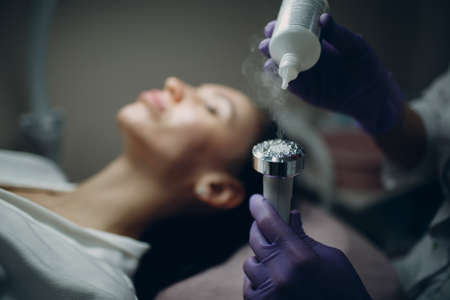Introduction to Microdermabrasion
Microdermabrasion has become a staple in the world of aesthetic medicine, particularly across the United States, thanks to its remarkable ability to rejuvenate and refresh the skin with minimal downtime. At its core, microdermabrasion is a non-invasive procedure that gently exfoliates the outermost layer of dead skin cells using fine crystals or a diamond-tipped wand. This process not only smooths the skin’s texture but also stimulates collagen production, helping to improve the appearance of fine lines, sun damage, and mild scarring.
The technique itself is straightforward yet highly effective. During a typical session, a specialized device is used to spray tiny crystals onto the skin or employ a diamond tip to abrade the surface while simultaneously vacuuming away debris and impurities. This controlled exfoliation encourages cell turnover and enhances the skin’s natural healing process. Because of its gentle approach, microdermabrasion is suitable for most skin types and tones, making it accessible to a broad range of individuals seeking noticeable improvements without surgical intervention.
One of the key reasons for microdermabrasion’s enduring popularity in aesthetic practices throughout the U.S. is its reputation as a “lunchtime procedure.” Treatments are quick—often completed within 30 minutes—and require little to no recovery time, allowing clients to resume their daily activities right away. Additionally, its versatility means it can address multiple skin concerns, from dullness and uneven tone to minor acne scars and enlarged pores.
In summary, microdermabrasion stands out as an essential component of modern skincare regimens due to its safety profile, convenience, and proven results. As we explore its history and evolution in subsequent sections, it becomes clear why this technique remains a go-to choice for both patients and practitioners aiming for healthier, more radiant skin.
2. Origins and Early Developments
Microdermabrasion, now a staple in aesthetic medicine clinics across the United States, has a fascinating origin story that spans continents and decades. The concept of using abrasive techniques for skin rejuvenation dates back to ancient civilizations—Egyptians reportedly used sandpaper to smooth scars as early as 1500 B.C. However, modern microdermabrasion as we know it began taking shape in Europe during the late 20th century.
In the mid-1980s, Italian dermatologists pioneered a less invasive method than traditional dermabrasion, aiming to minimize discomfort and downtime for patients. Their technique utilized a controlled stream of fine crystals to exfoliate the outermost layer of the skin, making it gentler and more suitable for a wider range of skin types. This innovation quickly gained traction throughout Europe due to its effectiveness and minimal recovery period.
The table below highlights key milestones in the global development of microdermabrasion:
| Year | Location | Development |
|---|---|---|
| 1500 B.C. | Egypt | Early use of sandpaper for skin smoothing |
| 1985 | Italy | Introduction of crystal-based microdermabrasion by dermatologists |
| 1996 | United States | First FDA-approved microdermabrasion device introduced |
The technology crossed the Atlantic in the mid-1990s, where it was met with enthusiasm by American skincare professionals eager for non-surgical solutions. By 1996, the first FDA-approved microdermabrasion devices were available in the U.S., paving the way for rapid adoption in both medical and spa settings. American practitioners adapted European methods to align with local regulations and consumer preferences, incorporating safety standards and marketing approaches unique to U.S. culture. This blend of international innovation and American ingenuity set the stage for microdermabrasions enduring popularity in the beauty industry.

3. Technological Advancements Over Time
The journey of microdermabrasion in aesthetic medicine has been marked by significant technological advancements, each aimed at enhancing safety, effectiveness, and overall patient comfort. In the early days, microdermabrasion devices were relatively rudimentary, often relying on basic crystal-based systems that manually exfoliated the skin’s surface. While these early machines paved the way for non-invasive skin rejuvenation, they had limitations in terms of precision and control.
As the field evolved, manufacturers began integrating more sophisticated technologies. One major shift was the transition from traditional crystal systems to diamond-tip devices. Diamond-tip microdermabrasion offered a gentler and more precise exfoliation process, minimizing the risk of uneven abrasion or residual particles on the skin. This innovation not only improved treatment outcomes but also reduced post-procedure downtime and discomfort for patients.
Another key advancement involved the introduction of adjustable suction settings and varying tip sizes. These features allowed practitioners to customize treatments based on individual skin types and concerns, further improving both safety and results. Modern machines now feature intuitive user interfaces and advanced filtration systems, which help ensure a hygienic experience while preventing cross-contamination between clients.
In recent years, microdermabrasion technology has continued to evolve with a strong emphasis on patient comfort. Many contemporary devices incorporate cooling elements or soothing serums delivered simultaneously during treatment, making sessions more comfortable—even for those with sensitive skin. Additionally, integration with digital monitoring tools helps practitioners track progress and tailor ongoing care plans effectively.
These technological advancements reflect a broader commitment within American aesthetic medicine to prioritize patient well-being without compromising results. As the equipment and methodologies for microdermabrasion have become more refined, patients can now enjoy safer procedures with enhanced outcomes—making this treatment an increasingly popular choice across the United States.
4. Cultural Acceptance and Mainstream Adoption
Microdermabrasion’s journey from a novel clinical treatment to a mainstream American skincare practice is a testament to its adaptability and effectiveness. In the early years, microdermabrasion was primarily offered in dermatology clinics and medical spas, where only licensed professionals could perform the procedure. However, as Americans became increasingly interested in proactive skincare and age prevention, the demand for minimally invasive treatments like microdermabrasion skyrocketed.
This shift coincided with a broader cultural embrace of self-care and personal wellness, making professional skin treatments more socially acceptable and even trendy. Celebrities and influencers began openly discussing their microdermabrasion experiences, further reducing stigma and increasing its desirability among the general public.
By the early 2000s, advancements in technology allowed for the development of at-home microdermabrasion devices. These accessible tools brought professional-grade exfoliation into American bathrooms, making it possible for individuals to maintain their glow between clinic visits or as a convenient alternative to professional care.
Comparison: Clinical vs. At-Home Microdermabrasion
| Setting | Provider | Intensity | Cost | Frequency |
|---|---|---|---|---|
| Clinical (Dermatology/Medical Spa) | Licensed Professional | Higher | Higher per session | Monthly or as recommended |
| At-Home Devices | User (Self-administered) | Milder | One-time investment | Weekly or bi-weekly |
The rise of microdermabrasion as a staple in American skincare reflects not just technological evolution, but also changing cultural attitudes toward self-improvement and aesthetics. Today, whether in a dermatologist’s office or at home, microdermabrasion is widely accepted as a safe, effective way to achieve smoother, brighter skin—a true example of how innovation can shape beauty rituals across the United States.
5. Regulatory Landscape and Professional Guidelines
The integration of microdermabrasion into aesthetic medicine in the United States has been significantly influenced by evolving regulatory frameworks and professional standards. Over the years, various state boards—most notably those governing cosmetology and medical practices—have established clear guidelines to ensure both practitioner competency and patient safety. The Food and Drug Administration (FDA) plays a pivotal role, classifying most microdermabrasion devices as Class I or II medical devices depending on their intended use and technical specifications. This classification requires manufacturers to adhere to strict safety and efficacy standards before marketing their equipment.
On a professional level, organizations such as the American Society for Dermatologic Surgery (ASDS) and the American Med Spa Association (AmSpa) have issued position statements and best-practice guidelines regarding who may perform microdermabrasion, under what circumstances, and with which types of devices. Typically, these guidelines recommend that licensed estheticians or healthcare professionals with appropriate training conduct the procedure, particularly when more aggressive modalities are used.
State regulations can differ widely: some states restrict microdermabrasion to medical offices, while others permit certified estheticians to provide treatments in spas or salons, provided they follow specific protocols. Furthermore, ongoing education requirements ensure practitioners remain updated on device technology advances, infection control procedures, and client assessment techniques.
This layered regulatory environment has helped establish trust among consumers, minimize adverse events, and foster responsible innovation within the field. As a result, microdermabrasion has become a mainstay in American aesthetic practices—valued for its safety profile, versatility, and accessibility when performed according to established standards.
6. Current Trends and Innovations
As microdermabrasion continues to hold a prominent place in the world of aesthetic medicine, the treatment has evolved far beyond its original scope. Today, the landscape is defined by groundbreaking technologies, integrated treatment plans, and a shift in what American consumers expect from their skincare experiences.
Emerging Technologies in Microdermabrasion
Modern microdermabrasion devices are more sophisticated than ever. Crystal-free systems—like diamond-tipped wands—have become increasingly popular due to their precision and reduced risk of irritation. Some state-of-the-art machines now combine suction with customizable abrasive surfaces, enabling providers to tailor treatments to diverse skin types and conditions. The integration of LED therapy, oxygen infusion, and even ultrasound technology further enhances results, promoting skin rejuvenation beyond mere exfoliation.
Combination Therapies
One of the biggest trends in contemporary American aesthetic clinics is the combination of microdermabrasion with other non-invasive procedures. Pairing microdermabrasion with chemical peels, hydrating serums, or microneedling can amplify benefits like improved texture, brightness, and hydration. This synergistic approach allows for more comprehensive results while minimizing downtime—a key factor for busy clients seeking visible improvements without interrupting their daily routines.
Personalization and Customization
Todays clients expect treatments to be tailored precisely to their individual needs. Providers frequently assess skin type, lifestyle factors, and specific concerns before recommending a treatment protocol. Customizable settings on modern machines allow for gentle exfoliation on sensitive skin or deeper resurfacing for those needing more intensive care. This personalized approach helps ensure both safety and satisfaction.
Changing Consumer Preferences
In the U.S., there has been a noticeable shift toward holistic skincare. Clients are not just looking for quick fixes—they want long-term improvements that fit seamlessly into their wellness routines. As a result, providers emphasize education about at-home care following microdermabrasion and offer maintenance packages to support ongoing skin health. There’s also greater demand for treatments using “clean” ingredients and cruelty-free practices, reflecting broader shifts in consumer values.
The Rise of At-Home Devices
Another notable trend is the increasing popularity of at-home microdermabrasion kits. While professional treatments remain the gold standard for safety and efficacy, high-quality consumer devices have made it easier for Americans to maintain glowing skin between appointments. However, experts still recommend periodic visits to licensed professionals for optimal results.
Together, these innovations and evolving preferences keep microdermabrasion at the forefront of aesthetic medicine in the United States—demonstrating how this classic procedure continues to adapt to meet the needs of today’s beauty-conscious consumers.
7. Future Perspectives in Aesthetic Medicine
As we look toward the future of microdermabrasion within the evolving landscape of American aesthetic medicine, it’s clear that both technology and patient expectations are rapidly shaping new horizons. With ongoing research and innovation, practitioners and patients alike are anticipating more personalized, efficient, and synergistic approaches to skin rejuvenation.
Integration with Advanced Technologies
One of the most exciting trends on the horizon is the integration of microdermabrasion with emerging technologies. Devices that combine microdermabrasion with modalities like radiofrequency, LED light therapy, or ultrasound are being developed to enhance treatment outcomes. These hybrid systems aim to provide not only exfoliation but also deeper stimulation for collagen production and skin tightening—addressing multiple skin concerns in a single session.
Personalized Treatment Protocols
The move toward personalized skincare in America is also influencing how microdermabrasion is practiced. Advances in diagnostic tools such as digital skin analysis allow providers to customize treatments based on an individual’s unique skin characteristics. This personalization is expected to improve results, reduce downtime, and increase overall patient satisfaction.
Emphasis on Non-Invasive and Preventative Care
American consumers are increasingly interested in non-invasive procedures that offer minimal recovery time and natural-looking results. As such, microdermabrasion is likely to maintain its popularity as a gentle yet effective option for preventative care—especially among younger generations seeking to delay visible signs of aging without surgery or injectables.
Ongoing Research and Clinical Studies
Research continues into optimizing microdermabrasion techniques, from refining crystal-free devices to developing novel abrasive materials designed for specific skin types or conditions. Additionally, studies are examining how combining microdermabrasion with topical agents (such as antioxidants or peptides) can enhance penetration and efficacy, opening new avenues for advanced cosmeceutical therapies.
The Road Ahead: Accessibility and Education
The future will likely see greater accessibility to professional-grade microdermabrasion through telemedicine consults, at-home devices with enhanced safety features, and wider education for both providers and patients on safe practice protocols. As American consumers become more informed about their options, transparency and evidence-based recommendations will be essential components of responsible care.
In summary, while microdermabrasion has come a long way since its introduction, its evolution is far from over. The convergence of cutting-edge technology, personalized protocols, and an emphasis on holistic wellness ensures that microdermabrasion will remain a cornerstone of aesthetic medicine in America—adapting to meet the needs of future generations with safety, effectiveness, and innovation at its core.


